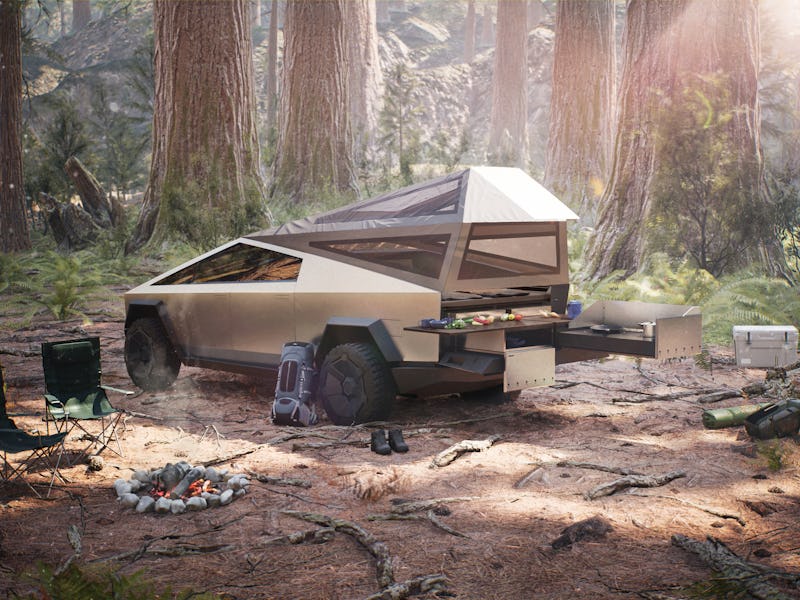Tesla Cybertruck: Elon Musk teases key features for exploring wilderness
Tesla's most intriguing vehicle looks set to offer capabilities that will appeal to the explorer.

The Tesla Cybertruck could become an explorer's best friend.
The oddly-shaped electric truck, set to launch late 2021 with a starting price of $39,900, strikes a unique shape compared to competitors like the Ford F-150. But CEO Elon Musk declared on Twitter Monday that, just because the truck looks like it rolled off the set of a sci-fi film, it's going to offer some key benefits that make it invaluable for exploring the real-world wilderness.
In response to questions from Twitter users "batflyer" and "tobyliiiiiiiiii," Musk confirmed that the truck would be able to cross water streams without damaging the truck, writing that it would even "float for a while." Musk also confirmed that the truck would offer the same heat pump as seen on the Model Y compact SUV that started rolling out last month, a key feature for saving electricity.
"Aargh, I’m dying to make Cybertruck like yesterday!!" Musk wrote.
Musk's announcement.
The comments show how, despite the truck's seemingly futuristic shape, the firm is planning to also offer benefits for the main target consumer. The heat pump has been a welcome addition to the Model Y, as it helps move heat around the vehicle and reduce the need for turning up the heaters in colder conditions. This can help with improving the maximum battery range, expected to be over 500 miles on the high-end Cybertruck.
And despite the perception that electricity and water don't mix, it seems Tesla is aiming to enable the Cybertruck to traverse streams. Musk didn't reveal the wading depth of the Cybertruck, however. The Ellsworth American reported in January 2017 that the Ram Power Wagon has a maximum wading depth of 30 inches deep. The Rivian R1T, an all-electric pickup truck scheduled to start production in the second half of 2020, has a maximum wading depth over three feet, or over 36 inches.
The comments also demonstrate how, for Musk, the Cybertruck is something of a passion project. In November 2018, around a year before Musk unveiled the design, he described the truck's appearance in an interview as "heart-stopping," adding that "I actually don’t know if a lot of people will buy this pickup truck or not, but I don’t care." Ahead of the reveal, pickup truck owners told Inverse in March 2019 that they were concerned about whether the truck would meet their expectations.
Tesla Cybertruck out in the wilderness.
But so far, the Cybertruck has enjoyed a warm reception. The truck's unveiling made headlines when a demonstration of the windows' strength went wrong, but buyers still rushed to pre-order the truck for a $100 deposit. A third-party tracker in February 2020 suggested the truck had received over 535,000 reservations since the unveiling, more than the Model 3 had the month after production started in July 2017. It should be noted that the Model 3 did require a $1,000 deposit, 10 times higher than the truck.
This warm reception has filtered down into analyst expectations. Loup Ventures in March announced it had changed its predictions for Cybertruck production as a percentage of total production. Where it previously expected the truck to account for just five percent of production when the truck reached full production, predicted to be 2023, it now expected it to account for 15 percent of production.
The Inverse analysis
The Cybertruck has appealed to fans beyond the traditional pickup truck audience, but the truck's features suggest it is considering what its target audience craves.
The Cybertruck add-ons.
Beyond these new features, Tesla has released an image of the Cybertruck fitted out with campfire equipment for the ultimate outdoors picnic. Musk has also announced plans for an add-on all-terrain vehicle, as well as solar wings that can add up to 40 miles of driving distance per day. It has onboard power outlets, compressed air, and the ability to tow over 14,000 pounds.
Musk may be demonstrating the Cybertruck on the flat streets of California, but it seems the truck will be built to support the audience that helped make the Ford F-150 the United States' best-selling car.